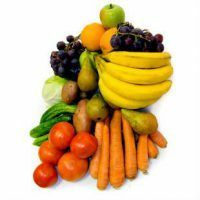
The importance of folic acid( vitamin B9) for the normal functioning of the body is difficult to overestimate. It is indispensable in the synthesis of leukocytes, the production of endorphins, the production of DNA, the functioning and normal development of the immune, endocrine and cardiovascular systems. Therefore, it is important to know in what products and in what quantities folic acid is contained.
- Folic acid use for women
- Foods rich with folic acid
Folate use for women
Its consumption in sufficient quantities helps to maintain and improve women's health in different periods of her life.
In adolescence, folic acid:
- regulates the menstrual cycle;
- corrects the sexual maturation of girls;
- prevents early development of osteoporosis;
- helps fight acne;
- promotes the production of blood cells;
- promotes the growth of healthy hair;
- favorably affects the psyche of a teenage girl;
- improves appetite;
- helps the work of the stomach and liver;
- increases immunity;
- promotes good functioning of brain cells.
During pregnancy, consumption of folic acid( at least 500 micrograms):
- promotes normal fetal development;
- provides the synthesis of DNA and RNA;
- promotes the formation of the nervous system of the embryo;
- provides a normal development of the neural tube of the fetus;
- reduces the risk of mental retardation;
- helps reduce the risk of complications during pregnancy;
- provides protein, fat and carbohydrate metabolism of the woman's body;
- promotes the assimilation of iron;
- promotes the formation of red, white blood cells;
- improves the efficiency of the liver;
- lowers cholesterol in the blood.
During the postpartum period, folic acid intake helps women:
- cope with postpartum depression;
- to enhance immunity;
- recover faster after delivery;
- improve the condition of the skin and hair.
In adulthood, folic acid:
- supports the immune system;
- promotes pigmentation alignment;
- reduces the risk of breast cancer;
- is the prevention of anemia;
- reduces the risk of ovarian cancer;
- has an effect on the digestibility of vitamins;
- promotes the production of endorphins;
- improves heart function;
- promotes normalization of digestion processes;
- prolongs female youth, pushing back menopause;
- promotes stress resistance.
Products rich in folic acid
List of products rich in folic acid( content per 100 grams):
Greens:
- green asparagus - 262 micrograms,
- parsley - 117 micrograms
- spinach - 80 micrograms,
- green salad - 48 micrograms,
- wild garlic - 40 micrograms,
- dill - 27 micrograms,
- beet topped with beet - 18.5 micrograms,
- onion green- 18 micrograms.
Vegetables:
- cabbage( Brussels) - 31 micrograms,
- cabbage color - 23 micrograms,
- eggplant - 18.5 micrograms,
- cornichons - 18.5 micrograms,
- Jerusalem artichoke - 18.5 micrograms,
- cabbage( red) - 19 micrograms,
- zucchini - 14 micrograms,
- beets - 13 micrograms,
- tomatoes - 11 micrograms,
- white cabbage - 10 micrograms,
- green pepper - 10 micrograms,
- onion - 9 micrograms,
- carrots - 9 micrograms,
- potatoes - 8 micrograms,
- cucumber - 4 micrograms.
Fruits, berries, melons:
- strawberries - 20 micrograms,
- kiwis - 18.5 micrograms,
- peach - 8 micrograms,
- garnet - 18 micrograms,
- figs - 10 micrograms,
- sea buckthorn - 9 micrograms,
- watermelon - 8micrograms,
- cherries - 6 micrograms,
- raspberries - 6 micrograms,
- currants black - 5 micrograms,
- gooseberries - 5 micrograms,
- grapes - 2 micrograms,
- apples - 2 micrograms,
- pears - 2 micrograms.
Citrus:
- lemon - 9 micrograms,
- orange - 5 micrograms.
Mushrooms:
- white - 40 micrograms,
- oil - 30 micrograms,
- champignons - 30 micrograms.
Cereals, cereals:
- Wheat of solid grades - 46 micrograms,
- flour of coarse grinding - 40 micrograms,
- rye - 35 micrograms,
- rice - 35 micrograms,
- buckwheat groats - 32 micrograms,
- barley cereals - 32 micrograms,
- oats -29 micrograms,
- pearl barley - 24 micrograms.
Pulses:
- lentils - 180 micrograms,
- peas - 160 micrograms,
- beans - 90 micrograms.
Nuts:
- peanuts - 240 micrograms,
- walnuts - 77 micrograms,
- hazelnuts - 68 micrograms,
- almonds - 40 micrograms.
Dairy products:
- brynza - 35 micrograms,
- hard cheese - 19 micrograms,
- cheese fused - 14 micrograms,
- cream - 10 micrograms,
- curdled milk - 7.4 micrograms,
- milk - 5 micrograms.
Products of animal origin:
- Beef liver - 240 micrograms,
- chicken liver - 240 micrograms,
- liver pork - 225 micrograms,
- turkey - 9.6 micrograms,
- chicken egg - 9 micrograms,
- beef - 8 micrograms,
- lamb -8 micrograms,
- rabbit - 7.7 micrograms,
- quail, duck - 7.5 micrograms,
- beef tongue - 6 micrograms,
- quail egg - 5.6 micrograms,
- chicken - 4.3 micrograms,
- pork - 4,1 microgram.
Fish:
- cod liver - 110 micrograms,
- cod - 11.3 micrograms,
- scad - 10 micrograms.
Therefore, whenever possible, it is better to eat vegetables and fruits in raw form.
